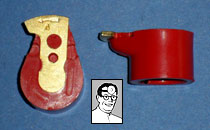SRQJeff
Bronze Level Sponsor
Hey, folks. I'm stumped again, hoping someone can help. I'm not getting any spark for some unknown reason. As far as I can tell, I'm supposed to be getting power to the coil from the wire that runs from the bottom of the solenoid switch, along the firewall, and to the positive terminal on the coil. No juice, though. The wiring diagram makes it look like the power should be coming from the ignition switch, but mine isn't wired that way (and neither is the parts car in the back yard). Bad solenoid switch possibly? It cranks over nicely, but it could be something wrong with that lower connection, I guess. Anyway, for your kind consideration I offer something I ran into recently: an official 48-page Lucas fault diagnosis manual. Just go to www.jkeckert.com/freedownloads/LucasFaultManual.pdf. It shows a direct connection from the coil to the iggy switch, too, so it didn't do me much good.



